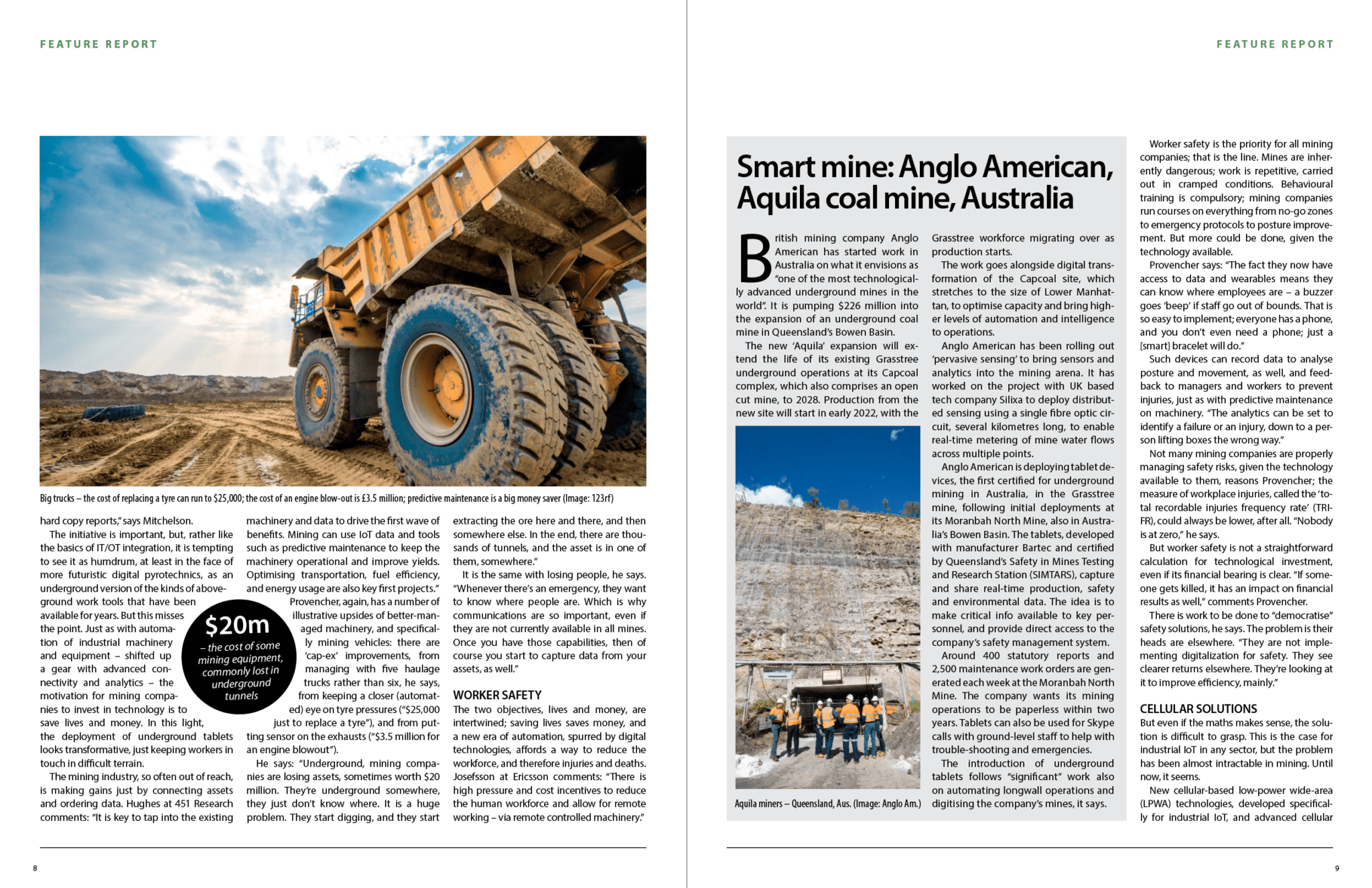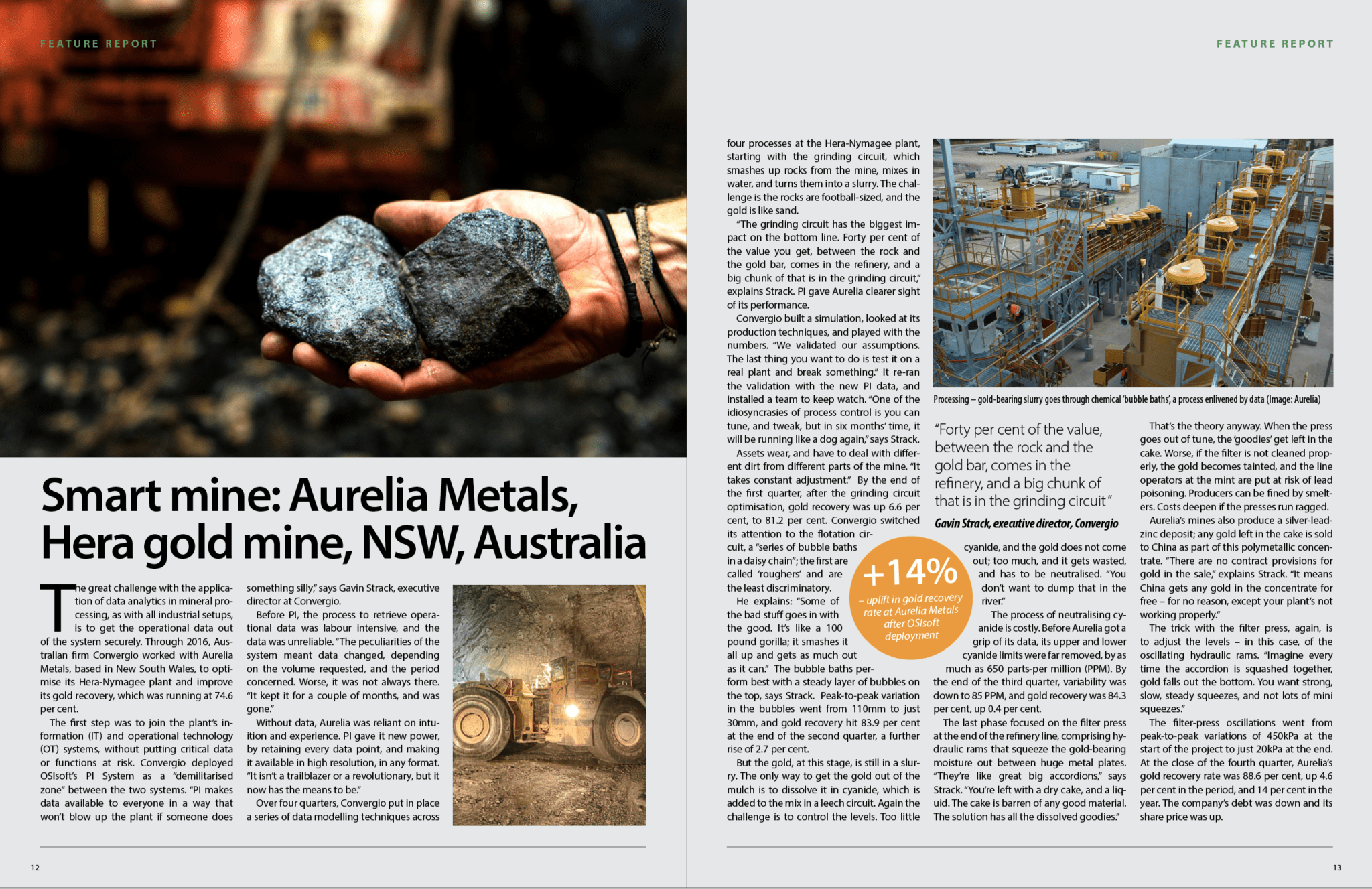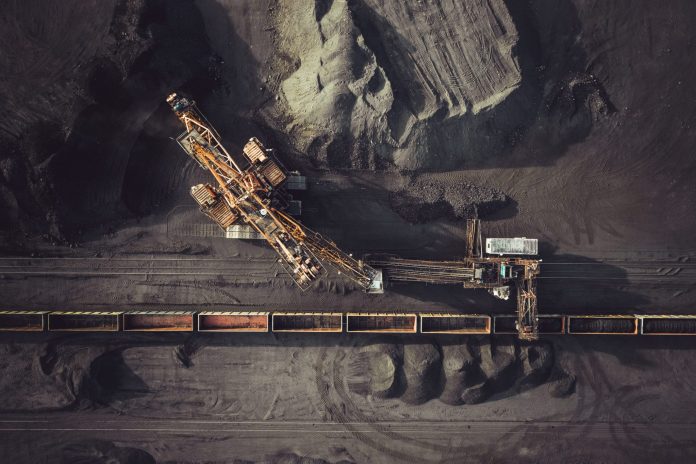This article continues from here (part 2). It is also available to download (for free) in full, as a standalone report – from here. The report features additional information. It forms part of Enterprise IoT Insights’ ongoing Making Industry Smarter report series, which has also covered Energy & Power, Agriculture & Farming, Supply Chain & Logistics, Cities & Towns, and Production & Manufacturing.
CELLULAR SOLUTIONS
But even if the maths makes sense, the solution is difficult to grasp. This is the case for industrial IoT in any sector, but the problem has been almost intractable in mining. Until now, it seems.
New cellular-based low-power wide-area (LPWA) technologies, developed specifically for industrial IoT, and advanced cellular broadband networks, for higher-end analytics, provide a two-tier springboard for industrial IoT. There is rising need for these technologies as replacements for legacy Wi-Fi and cable systems, and as alternatives to non-cellular LPWA technologies.
Milosevic at Telit comments: “Sensor and actuator networks in mining environments are dense and getting denser, particularly with the use of more higher-resolution cameras, both static, as well as on mobile assets like trucks and rail cars.
“As these networks get denser, they are running into limitations for legacy wireless. Cellular LPWA and private LTE are quickly getting traction with mines and their solution providers and integrators.”
She adds: “Cellular LPWA and private LTE offer improved scalability, security, and automation of device onboarding. They are powerful pillars to enhance current solutions and enable concepts like zero-touch device provisioning for assets being added or reconfigured in a sensor or control network.”
 At the higher end, LTE and 5G bring higher throughputs and lower latencies for edge-based analytics, as well as higher-grade reliability and industrial control. Their availability in private installations, using dedicated or shared spectrum, is also turning heads, in a sector running critical infrastructure in hazardous environments.
At the higher end, LTE and 5G bring higher throughputs and lower latencies for edge-based analytics, as well as higher-grade reliability and industrial control. Their availability in private installations, using dedicated or shared spectrum, is also turning heads, in a sector running critical infrastructure in hazardous environments.
Peter du Bruin, master researcher at Ericsson, suggests remote control of machines and smart ventilation are the two most crucial use cases in improving safety and efficiency in mines. Ericsson has worked with Swedish mining and smelting company Boliden to deploy private LTE at its Aitik copper mine, outside the town of Gällivare in northern Sweden.
“With low latency and ultra-high speed connectivity, remote control applications with multiple feedback sources – such as video, audio, haptic – are enabled; helping to avoid having people in the most dangerous areas, and at the most dangerous times,” says du Bruin.
“This, in turn, improves productivity because it shortens the time between a blast and when the miners can enter the area. Additionally, numerous sensors in the mine can be connected, together creating huge amounts of data, to be analysed in near real-time. Using this data, the steering of ventilation can be optimised, providing better air supply as well as improved efficiency, which enables full control of the mining environment.”
Ericsson has also implemented a connected rock bolt solution. Rock bolts stabilise underground tunnels by distributing stress evenly along the length of the bolt, from the unstable surface to the stable interior of the rock mass. Bolts with in-built sensors provide data about vibrations in the rock – to make sure the environment is secure.
The Aitik mine had reduced costs by one percentage point through application of automation technologies. Carrying out drilling and blasting using automation shows an annual €2.5 million net saving for the Aitik mine alone, it says. Communications technologies are the key enabler for this.
“Although not the only option, mobile fits the bill perfectly as a solution for mining and offers a major business opportunity,” says du Bruin.
There are other examples of private deployments of industrial-grade cellular (see page 16 of report). Ericsson is working with Australian operator Telstra on a number of private LTE deployments in mines, including “one of the largest underground mining LTE networks in the world” for Perth-based metals company South32.
The deployment, at the Cannington Silver Mine in Queensland, will run underground for 6.5-kilometres, using a private, virtualised core and radio technologies distributed over ‘leaky feeder’ cable using LTE-capable bi-directional amplifiers.
Leaky feeder cables are like coaxial cables without the copper sheath; instead they have small gaps to allow a radio signal to get through and create a limited wireless network. They have been the default communications solution for mines, until now.
Telstra is in pre-deployment stage. Jeannette McGill, the company’s head of mining services, says: “The network will drive improved safety, automation and mechanisation and will connect staff to vehicles and sensors around the mine at all times. The high throughput and low latency offered by the system means staff will be able to control critical equipment without interruption.”
Industrial-grade LTE and 5G, with ultra-reliable low-latency (URLLC) advancements coming in Release 16 of 5G NR, appeal to enterprises for the capabilities as control networks. Telstra and Ericsson have a similar gig with Newcrest’s Lihir gold mine in Papua New Guinea. The network has been able to resolve challenges with existing Wi-Fi connectivity, the pair say.
McGill comments: “They’ll be using it to further modernise the mine site to enable the use of current and future mining applications, including tele-remote and autonomous systems, more extensively.”
Chris Jordaan, general manager for Newcrest Lihir, says: “Tele-remote and autonomous mining technologies are fundamental to working the hot work areas that will become more dominant features of our operation in the future. Private LTE will be a great enabler for these technologies and coupled with the existing in-pit Wi-Fi network, we have been able to create a heterogeneous network that covers the whole mining lease.”
SMALLER STEPS
Although these private cellular setups will incorporate low-power wide-area (LPWA) NB-IoT and LTE-M, they are geared towards higher-end automation and industrial control. Most mining companies would prefer to start with a single step, with data integration and wide-area connectivity, than a giant leap, with high-end streaming analytics and machine learning.
This is the view of Evans from MAJiK Systems, who we heard from at the top of the piece. He is working in the ming industry with a new low-power wide-area (LPWA) technology that uses an ETSI-approved technique called ‘telegram splitting’ (over ultra narrowband, or TS-UNB) for “last mile” industrial communications. As such it goes up against the likes of LoRaWAN, Sigfox, NB-IoT, and LTE-M, variously pushed by their backers as springboards for industrial IoT.
Evans comments: “I don’t think mining or manufacturing, or oil and gas or any of these industries, are as far along as some people outside of these industries think they are. A lot are just doing their first explorations into using data at scale to impact their operations. It’s very new to them.”
 More than this, he thinks the hype around 5G is unhelpful, and that private cellular infrastructure is prohibitively expensive. The TS-UNB solution MAGiK is pushing, licensed from fellow Canadian BehrTech, branded as MIOTY, supports out-of-the-box connectivity in license-free sub-gigahertz spectrum from a single base station, with support for up to 100,000 sensor nodes in a 15 kilometre radius.
More than this, he thinks the hype around 5G is unhelpful, and that private cellular infrastructure is prohibitively expensive. The TS-UNB solution MAGiK is pushing, licensed from fellow Canadian BehrTech, branded as MIOTY, supports out-of-the-box connectivity in license-free sub-gigahertz spectrum from a single base station, with support for up to 100,000 sensor nodes in a 15 kilometre radius.
The pair have tweaked the solution – which combines with MAJiK’s own analytics software for industrial programmable logic controllers (PLCs) – so there is enough compute power and intelligence in the base station unit to support edge-based processing, and to bring decent latencies to industrial operations.
“The solution we’ve put together with BehrTech is great for mining companies because they can really easily and quickly in an ad hoc manner connect more devices, get more analytics, and keep building, from first implementations until they cover the whole mining complex,” explains Evans.
“With 5G, you’re going to have to outlay money for infrastructure, right away. Industrial companies don’t want to buy like that. They want to prove the value from IoT on small projects, and to expand from there. I don’t see 5G being able to do that, especially private 5G. Until that goes away, for the next five or 10 years, industrial will build networks ad hoc, seek to repurpose hardware, and drive ROI at a low level, before they invest huge sums.”
GRAND POTENTIAL
BehrTech and MAJiK are working with the largest open pit gold mine in North America, somewhere in Canada (the company in question does not want to be named). Their experience addresses these challenges of computing and connectivity in this market – in this case, how to beam a signal across a “man-made mountain” of low-yield ore, piled up for brutalist treatment with a delicate cyanide solution.
The story goes like this (and rather like the Aurelia Metals retelling on pages 12-13 of report). In gold mining, high-yield gold is extracted for processing in a mill; lower-yield stuff gets dumped in a heap. At the Canadian gold mine, this heap reaches for a square kilometre, and rises half a kilometre high.
Cyanide is mixed with a lime alkali to just the correct pH level, and sprayed onto the mountain, to drip through over time and leach out the gold in a liquid. But each rock pile requires a different pH: too acidic, and gold is lost; too alkaline, and rock stays in. It is a fine balance.
The Canadian miners had struggled just to know the levels in their lime silo, a six-storey high chute with a funnel at the bottom. “The only way was to press a button, and see if anything came out,” explains Albert Behr, chief executive at BehrTech.
“Someone had to jump on a bike and drive twice a day to the equipment. If it went down, it could be six hours before anyone realised, cascading issues down the line,” says Evans.
No fewer than 50 sensors had been attached to the silo, connecting with an old Allen Bradley PLC, in order for a team in a ‘management shed’ on the other side of the mountain to be able to get a reading of the lime levels. But the data was stuck, literally, in the silo, unavailable beyond the PLC. “They tried everything – every one of the things you can think of,” explains Behr.
He runs through: “They tried cabling. But you can’t really fibre-up an industrial site like that. That doesn’t work very well. LoRaWAN? Forget it: way too much interference. Sigfox, NB-IoT? You need towers, so that doesn’t help. Ingenu? Same thing.”
It might be noted, each of these other technologies makes its own case; Semtech’s LoRa hardware and LoRaWAN networking has been used successfully in connecting conveyor belts in mines, notably, including in the case study from Transco Industries on page 9 of report).
But Behr goes on with the story. “The only thing that worked – sort of, maybe, not that great – was satellite, which is outrageously expensive and highly intermittent, especially at noon, when the sun is high. They were relegated back to driving around the mountain with a clipboard. Unbelievable, right?”
 The answer, of course, was in BehrTech’s MIOTY ‘telegram splitting’ tech, combined with MAJiK’s industrial analytics software. The MAJiK software collects data points from industrial machines (PLC ‘tags’), and a MIOTY transceiver transfers the data to a remote base station.
The answer, of course, was in BehrTech’s MIOTY ‘telegram splitting’ tech, combined with MAJiK’s industrial analytics software. The MAJiK software collects data points from industrial machines (PLC ‘tags’), and a MIOTY transceiver transfers the data to a remote base station.
Behr says: “We plugged into the ethernet jack, we tagged the PLC, and we were in and out in four hours, shooting a signal over the mountain. For the first time in 20 years, they were getting telemetry; they were blown away.”
Industrial control is a delicate and intensely private matter; a major issue for industrialists connecting OT and IT systems in the name of digital change is potential disruption to age-old processes, from misfiring software as well as from unknowable security threats.
It was not just the fact the silo measures showed up in the management shed, but that the old brownfield PLC at the limo silo, which had handled key processes for two decades, was not touched. “We had never seen the PLC before, and we did not touch the PLC code,” says Behr.
“That’s why ours turned from one project into four projects, immediately.”
Which is where we leave it; a valedictory tale about the grand potential of technology in mining, if only we can get it to work. And actually, a message about the simple effectiveness of extracting and crushing data, just by connecting existing machines and running easy analytics. Which is about where we are, in mining today.
This article is available to download (for free) in full, as a standalone report – from here. The report features additional information. It forms part of Enterprise IoT Insights’ ongoing Making Industry Smarter report series, which has also covered Energy & Power, Agriculture & Farming, Supply Chain & Logistics, Cities & Towns, and Production & Manufacturing.

